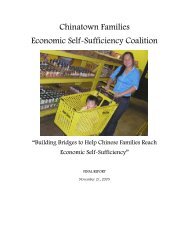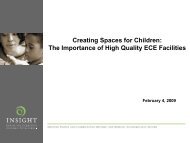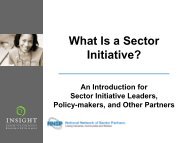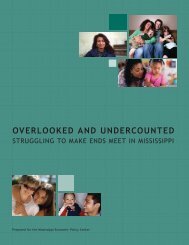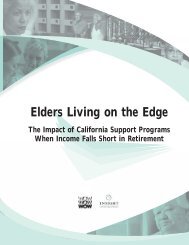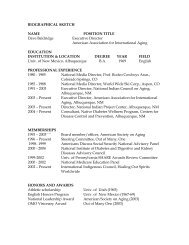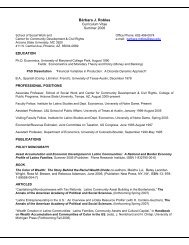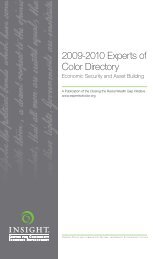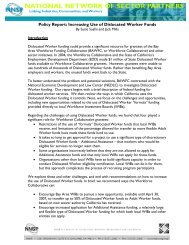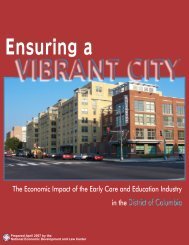Envisioning a Better Future for Working Families in Mississippi
Envisioning a Better Future for Working Families in Mississippi
Envisioning a Better Future for Working Families in Mississippi
You also want an ePaper? Increase the reach of your titles
YUMPU automatically turns print PDFs into web optimized ePapers that Google loves.
Current and Past Use of the Self-Sufficiency Standard<br />
Currently, ECD, the <strong>Mississippi</strong> Low-Income Child Care Initiative, and the National Community Tax Coalition<br />
–policy-oriented organizations <strong>in</strong> <strong>Mississippi</strong> – use the Standard <strong>for</strong> advocacy, public education,<br />
and/or fund development. As one child care advocate expla<strong>in</strong>ed,<br />
“We use it as an <strong>in</strong><strong>for</strong>mational tool to show why child care subsidies are so important.<br />
When press<strong>in</strong>g <strong>for</strong> more money to be put <strong>in</strong>to subsidies, we can talk about the difference it<br />
makes and give the message that child care is key to help<strong>in</strong>g people be able to work.<br />
Without subsidies, parents are not able to cover their other basic needs.”<br />
ECD uses the Standard to demonstrate the need <strong>for</strong> more fund<strong>in</strong>g <strong>for</strong> work<strong>for</strong>ce development programs, so<br />
that families can be tra<strong>in</strong>ed to enter <strong>in</strong>dustries that ultimately pay self-sufficiency wages. ECD has also used<br />
the Standard data <strong>in</strong> their reports, such as ECD’s Broaden<strong>in</strong>g the Base: Strengthen<strong>in</strong>g <strong>Mississippi</strong>’s <strong>Work<strong>in</strong>g</strong><br />
<strong>Families</strong>, Bus<strong>in</strong>esses and Economy Through Strong Child Care Systems, which highlighted unspent TANF<br />
funds and advocated that those dollars be redirected toward work<strong>for</strong>ce development and child care<br />
programs. ECD has used the Standard to evaluate the impact of their programs to measure, <strong>for</strong> example, if<br />
their commercial lend<strong>in</strong>g helped a bus<strong>in</strong>ess pay self-sufficiency<br />
level wages. F<strong>in</strong>ally, ECD cites the data <strong>in</strong> the Standard <strong>in</strong> oral<br />
testimony to the state legislature to support its overall policy<br />
work.<br />
While National Community Tax Coalition uses the Federal<br />
Poverty Guidel<strong>in</strong>es <strong>for</strong> research and advocacy “to skim the<br />
environment and show where people are at,” they use the Self-<br />
Sufficiency Standard “when it makes sense to pa<strong>in</strong>t a more<br />
detailed picture of low-<strong>in</strong>come folks and show where the gap<br />
lies.”<br />
“If the Self-Sufficiency<br />
Standard was tied to<br />
outcomes of the programs<br />
we fund, it could show if the<br />
organization is meet<strong>in</strong>g its<br />
goals.”<br />
Despite these examples, one research and advocacy<br />
organization concluded, “the Self-Sufficiency Standard has not yet affected advocacy <strong>in</strong> a mean<strong>in</strong>gful way”<br />
<strong>in</strong> <strong>Mississippi</strong>.<br />
<strong>Future</strong> Uses of the Standard<br />
The non-profit organizations <strong>in</strong>terviewed, be they advocates or direct service providers, reported that the<br />
Standard is capable of support<strong>in</strong>g the work of any organization work<strong>in</strong>g with low-<strong>in</strong>come communities and<br />
families s<strong>in</strong>ce it is a very valuable research and data source. The respondents were remarkably similar <strong>in</strong><br />
their perception and understand<strong>in</strong>g of possible uses of the Standard. This was reflected <strong>in</strong> their responses to<br />
the questions both on advantages and on challenges to adopt<strong>in</strong>g the Self-Sufficiency Standard. The only<br />
difference was the end use: either <strong>in</strong> public policy or programmatically. For example, compar<strong>in</strong>g the two<br />
largest groups of organizations i.e. direct service providers and advocacy organizations, the advocacy<br />
organization saw the Standard as a data and research tool to promote and back advocacy campaigns. It<br />
provides, as one leader put it, “a stronger base to make the case <strong>for</strong> family and work supports when talk<strong>in</strong>g<br />
to legislators, giv<strong>in</strong>g us an extra leg to stand on.” Similarly, service providers also saw the Standard as a<br />
research and data tool, but <strong>for</strong> program plann<strong>in</strong>g and expansion. As one work<strong>for</strong>ce development agency<br />
leader expla<strong>in</strong>ed, she envisioned us<strong>in</strong>g the Standard “to expand, establish, and retool exist<strong>in</strong>g programs.”<br />
<strong>Envision<strong>in</strong>g</strong> a <strong>Better</strong> <strong>Future</strong> <strong>for</strong> <strong>Work<strong>in</strong>g</strong> <strong>Families</strong>—February, 2010 Page 4



